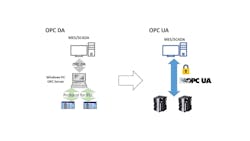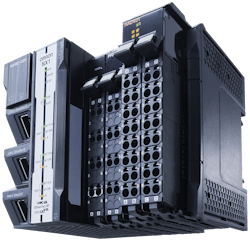The evolution of OPC UA with Omron Automation's Thomas Kuckhoff
Thomas Kuckhoff is product manager—controllers and industrial PCs—at Omron Automation.
What have been the most significant advancements/changes in technology that have affected OPC UA acceptance/implementation in the past five years?
Thomas Kuckhoff, product manager—controllers and industrial PCs, Omron Automation: The most significant advancement in technology around OPC UA is in the foresight of OPC UA developers to create connectivity for sharing information between industrial devices with zero code. There is support for tag-based access and extensive security options.
When there has been such great adoption over the past five years, hindsight bias is all too ready to become an alibi for cognitive dissonance. This may mask the fact that the most significant advancement is empowering so many manufacturers to leverage the foresight of OPC UA developers to help so many facilities start moving data without intruding on the performance of native architectures.
What’s the most innovative or efficient OPC UA application you’ve ever seen or been involved with?
Thomas Kuckhoff, product manager—controllers and industrial PCs, Omron Automation: Flexibility is rooted in the entropy we have generated surviving up to this point and debt we have accumulated as a result of our past technical decisions. The most innovative deployment of OPC UA is the deployment of connectivity to cut through the complexity and make an efficient path for data to get to a central database. An example that comes to the forefront in the development around the Automation Playback function, the advanced standard feature in the all-in-control platform technology. The Automation Playback is the convergence of data, video, program structure and ladder logic in the same development environment where programs are designed and commissioned through 3D simulation.
All playback is time-synced and event-triggered to allow local and remote team members to quickly and accurately diagnose issues without interrupting production. Of course, the only way to efficiently achieve this scale of data playback is integrating into current machines without requiring additional equipment on the plant floor. OPC UA connectivity does exactly this. Perhaps that makes OPC UA a bit of an unsung hero. Without database connectivity, data playback this efficient may not have been possible without connectivity as standard in Omron controllers.
How has OPC UA benefitted from the proliferation of components from multiple suppliers in machinery?
Thomas Kuckhoff, product manager—controllers and industrial PCs, Omron Automation: The foresight to develop database connectivity this open while creating connectivity for sharing information between industrial devices with zero code has been the rising tide to lift so many data-harvesting-capable devices on the plant floor. By making the connectivity open, the OPC Foundation has reduced inertia for adoptions which in turn has been the real catalyst for all users to benefit from the OPC Foundation network effect. As we look to the future, this openness to foster collaboration within the industrial-automation community could become a recipe for others to follow.
Can you explain how Industry 4.0 initiatives or the Industrial Internet of Things has impacted the use of OPC UA in manufacturing?
Thomas Kuckhoff, product manager—controllers and industrial PCs, Omron Automation: The methods to visualize data and take action are numerous. Regardless of using off-the-shelf third-party software or proprietary programs, facilities need a common method to safely transport the data. OPC UA is a huge part of this, not only because of the inherent design of the communication, but also because of the ability to leverage OPC UA while preserving the robustness of the control architecture.
What future innovations will impact the use of OPC UA in manufacturing operations?
Thomas Kuckhoff, product manager—controllers and industrial PCs, Omron Automation: To come back to security, future trends around data security will continue to shape the impact of OPC UA. More data on the plant floor is becoming confidential—to protect data from becoming part of a data lake for public generative artificial intelligence, to adhere to new legislation here in the United States or abroad or to simply protect trade secrets.
Simply sending data across networks which are susceptible to cyber threats can no longer be the industry standard operating procedure. Database connectivity will continue to be a topic for cybersecurity.
Tell us about one of your organization’s state-of-the-art OPC-certified products.
Thomas Kuckhoff, product manager—controllers and industrial PCs, Omron Automation: Integrating database functionality into the core of Omron control has been a great journey for the Sysmac control portfolio, and OPC UA has played a big role in that. While newer machine automation controllers in the Omron portfolio offer database functionality, such as OPC UA, as standard across all part numbers for that controller, such as the NX502, focusing on the controller which has offered database functionality as standard through a unique part number, such as the machine controller NX102, may be worth highlighting here. The NX102 has been a tried-and-true robust controller which serves at the perfect scale of control for a single machine, globally. While the NX102 has been serving programmable-automation-controller (PLC) programmers and key operation processes for years, it represented the continuation of Omron’s commitment to empowering the plant floor with OPC UA.
About the Author
Mike Bacidore
Editor in Chief
Mike Bacidore is chief editor of Control Design and has been an integral part of the Endeavor Business Media editorial team since 2007. Previously, he was editorial director at Hughes Communications and a portfolio manager of the human resources and labor law areas at Wolters Kluwer. Bacidore holds a BA from the University of Illinois and an MBA from Lake Forest Graduate School of Management. He is an award-winning columnist, earning multiple regional and national awards from the American Society of Business Publication Editors. He may be reached at [email protected]

Leaders relevant to this article:



